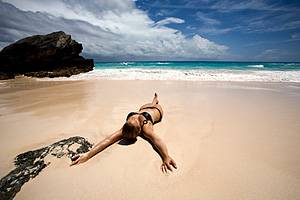How to choose keywords during attribution
6
For beginners uploading and attributing images on stock photography sites, one of the difficult steps is selecting keywords.
First, it is hard to decide which words will be key for a specific image; second, from the full list of possible words it is tricky to choose the most sellable keywords; third, many simply do not understand why keywords are needed. A question once came up: “Is it not enough if name and description are provided?”. Note that crafting keywords, or attribution, is an important step in working with stock photography agencies.
Why are keywords needed for images, what is their main purpose? Very simple: buyers on stock sites search for needed photos and illustrations by these words.
If the process of selecting the right keywords for an image is treated with great care, it can significantly increase sales going forward.
At the beginning it was emphasized that this article is for beginner contributors. That is accurate, because difficulties with keyword selection usually occur only at the start of working with stock sites.
Gradually, as experience grows, these difficulties disappear and creating a keyword list for an image will take very little time.
If the work stays within a single theme or direction, then creating the keyword list for new photos and illustrations will be a simple matter of copying keywords from one work to another with minor tweaks to a few keywords.
How to compile a keyword list
So, let’s dive into the process of composing a keyword list. First, understand that keywords must be written in English only and are usually separated by commas.
On average, the number of keywords hovers around 30, but never fewer than 7 and not more than 50.
Before starting to compile a list of relevant keywords for an image, look closely at the photo or illustration, identify the main objects, study the background and answer the questions: “Who? What kind? How many? Doing what? What? Which? Where? When? How?”
When answering, try to use words that precisely answer the question while also using synonyms that best characterize the scene in the image.
Let’s consider an example:

Let’s answer the key questions:
– main subject (model):
- Who? person, female, women, people
- What kind? sensuality, beautiful, adult
- How many? one
- Doing what? sunburn, resting, sunbathing, relax, relaxation, tan
– secondary objects (only main ones):
- What? wave, cloud, beach, sea, water, body, rock, sky, sand
- When? traveling, travel, summer, vacations, journey.
As a result, this photo gets the following keyword combo: sea, water, body, rock, wave, traveling, cloud, sky, women, person, human, female, people, beautiful, sensuality, sand, summer, vacations, adult, one, resting, relaxation, sunbathing, relax, sunburn, tan, beach, travel, journey.
Another example:

– main subject (model):
- Who? Woman, female, person
- How many? One
- What kind? Young, blond, beautiful, active, happy, caucasian
- Doing what? Hiking, climbing, smiling, sport, lifestyle
– secondary objects (only main ones): nature, outdoors, mountain, sea, rock, summer, travel, holidays.
As a result, the keyword combination for this shot is: woman, female, person, one, young, blond, beautiful, active, happy, caucasian, hiking, climbing, smiling, sport, lifestyle, nature, outdoors, mountain, sea, rock, summer, travel, holidays.
If there are language difficulties or trouble picking synonyms, online thesauruses and translation tools can be used.
There are also online keywording services -for example, the well‑known contributor Yuri Arcurs offers arcurs.com/keywording/.
Another tip when composing keywords is analyzing keyword lists on images with similar themes. But avoid blindly copying other people’s keywords.
Some contributors overuse words that don’t relate to the image. Yes, this might increase image sales in the short term, but stock sites will likely detect it quickly and the penalty can be harsh.
Also, some contributors use specific keywords to identify their own images. Such words may not suit another image.
So when reviewing other keyword lists, analyze and select only those that fit.
Note that it is unnecessary to describe everything in the image with keywords.
Focus only on the main objects and the background if it is noticeable. For instance, if a full‑length person is shown, there is no need to list every body part.
By the way, note that, for example, the stock site Fotolia gives preference and higher weight during indexing to keywords placed at the start of the list.
The most popular keywords on stock sites
Here is a list of commonly used keywords:
– if a photo or illustration contains people, always include: people, person
– if an image contains multiple objects of one type, indicate the count: two; three; …; group
– for people, specify gender and age:
- adult – 18 and older
- male – man
- female – woman
- woman – any adult woman
- man – any adult man
- young – young
- senior adult – older adult
- elderly – elderly
- teenager, teen – 13-17
- child, kid – ages 0-12
- boy – ages 0-12
- girl – ages 0-12
- baby – ages 0-2
- newborn – 0-1 month
- infant – 0-1 month
- toddler – 1-2 months
– indicate nationality with words like:
- Caucasian – a person of the white European race; for buyers this means any white person
- African – African
- Asian – Asian
- Chinese – Chinese
– also mark family relationships if present:
- family – family
- couple – couple
- parent – parent
- mother – mother
- father – father
- son – son
- daughter – daughter
- sister – sister
- brother – brother
- spouse – spouse
- husband – husband
- wife – wife
- grandparent – grandparent
- grandmother – grandmother
- grandfather – grandfather
- grandchild – grandchild
- granddaughter – granddaughter
- grandson – grandson
– if animals are present, do not forget their names: cat; dog; elephant; spider; etc.
For animals also add:
- animal – any animal
- wild animal – for wild animals
- domesticated animal – for pets and farm animals such as cattle, pigs, sheep, horses, etc.
- farm animal – when a farm animal is present
- pet – when the animal clearly belongs to a person
– as with people, indicate counts for animals: one; two; three; …; group.
– important keywords include photographic/illustration attributes:
- close-up – shot close up
- wide angle – shot with a wide angle
- backlit – main light from behind; subject details may or may not be in shadow
- toned – toned image; specify color (red; blue; yellow; sepia)
- soft focus – soft glow effect
- copy space – free space left for text
- texture – backgrounds or other images where the structure is shot close up
- vector – if it is a vector illustration
– for photos, specify the type:
- abstract – abstract content of indistinct forms, elements, colors (can be used as a background)
- background – an image used as a background for text or small images; usually uniform, solid, low‑contrast
- cutout – object on a featureless background, usually white
- exterior – exterior views of buildings and architectural forms
- interior – interior views of buildings, rooms, premises
- landscape – landscape
- portrait – portrait
silhouette – silhouette, a dark subject on a lighter background - skyline – city skyline; often used for cityscapes with buildings against the sky
vintage – for old or vintage‑styled photos
– be sure to mention setting, background, or location:
For example, use beach; city; countryside; farm; field; forest; home; hospital; house; office; restaurant; rocky; sandy; school; skyline; studio shot; suburban; subway.
Also common for setting:
- indoor – indoors or in transport
- outdoor – outdoors
- inside – when the subject is within another object (e.g., a dog peeking from a kennel)
- outside – outside (e.g., a person looking into a room through a window from the street)
- interior and exterior – analogous to inside and outside
- seascape – a beautiful sea view
- waterscape – views of water bodies, rivers, seascapes
- underwater – underwater shooting
- rural – for rural areas or agriculture
- urban – for urban life
– keywords that reflect the subject’s actions or activity.
Used for people, animals, and other objects. For example, cleaning; eating; exercising; falling; meeting; painting; relaxing; rock climbing; rolling; running; skiing; sleeping; swimming; talking; waiting; walking; working.
– do not forget events depicted in the photo or illustration: party; holiday; Christmas; accident; wedding; Valentine’s Day; graduation; picnic; birthday.
– types of natural phenomena: day; night; morning; afternoon; twilight; dawn; dusk; sunset; sunrise; summer; winter; autumn; fall; spring; storm; flood; tornado. Use seasonal keywords when the season is clearly visible in the image.
– it is important to use the correct keyword for the image’s theme:
- business – business theme; people in business suits, in offices, at work, in negotiations, with paperwork, at computers, in meetings, at presentations, etc.finance – finance theme: money, banking, investments, lending, loans, payments, and other financial topics
- money – any money images, paper or coins
- food – food and food preparation
- medical – anything related to medicine
- nature – anything that relates to nature and the natural world
- sports – sports scenes, professional or amateur
- art – art, paintings, drawings, sculptures, artworks, etc.
- architecture – architectural structures, especially those with a unique style or specific design
- leisure – leisure time: relaxing, sunbathing, playing, socializing, reading, etc.
- transportation – if any vehicle is present or the image relates to transport
- lifestyle – for active lifestyle themes (other than performing a job)
- agriculture – agriculture and related: crop and livestock, tilling, irrigation, harvest, etc.
- education – studying or learning (schools, classrooms, and learning‑related objects)
- entertainment – entertainment, concerts, performances, and related
- health – health, a healthy mind and body, vitamins, healthy food, and beneficial activities (e.g., jogging)
- healthcare – the healthcare system and related (e.g., medical facilities, people in hospitals, close‑ups of medicine vials); usually used alongside medical
- industry – industry (views of plants, factories, smokestacks, production, etc.)
- recreation – recreation, casual or sports games, hobbies
- travel – photos and illustrations related to travel or tourism
- wildlife – use for all images whose subjects belong to wildlife (e.g., birds, animals, and flora in natural habitats)
Attention! A tip to greatly simplify and speed up attribution: always save keywords into the image file (EXIF/IPTC) directly in the graphics editor.
Nearly all graphics editors on the market allow this.
Stop‑words for stock images
For illustrations and photos sold under a Royalty‑Free license, using images or names of trademarks is prohibited. Accordingly, using brand names in the keyword list is also forbidden (for example, Apple, Nokia, Coca Cola, McDonald, Mercedes, Microsoft, and others are stop‑words that must not be used).
This article is available in the following categories: About Microstocks, 123RF, Depositphotos, Dreamstime, Fotolia, Istockphoto, Shutterstock



It’s unclear how authors of vector mockups with tablets or phones manage to include keywords like iPad, iPhone, Apple, etc. There are many such images.
Thank you for the article! Everything is much clearer now :))
Thank you, this is helpful!
The text is written so poorly, it seems like a child with Down syndrome just wrote all their thoughts in a row.
Perdun, I tried to write in a way that would be understandable for someone just starting out in this field. I believe that for a beginner, materials that are detailed and explained in simple terms are just right.
Thank you for such information! It’s written very simply and clearly, especially for a clueless beginner. Everything about this monster is clear now, just need to put it into practice!